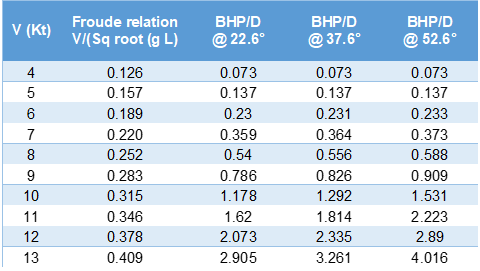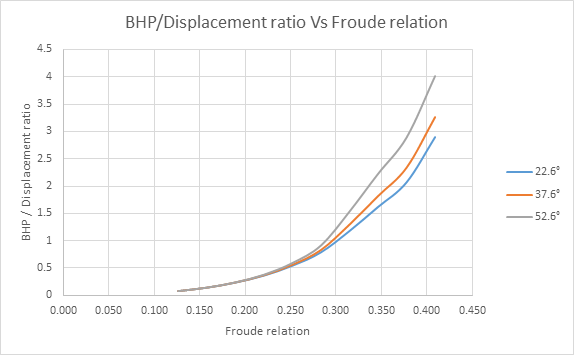|
The waterline is an imaginary line that separates the submerged part of the hull from the part that is out of the water. The angle of entrance is the
angle between the center line of the hull and the tangent to the design waterline on the ship's front perpendicular.

Performing the analysis at the angle of entrance is a useful tool to identify important characteristics of the boat.
To exemplify its use, we will analyze the behavior of the variation of the angle of entrance of a prototype boat with hydroconic shapes. This boat has 27.18
meters of floating length and generates a light displacement of 218.5 tons. For this example the boat has a 37.6° angle of entrance at the waterline.
It is necessary to generate a comparative table of the brake power at different angles of entrance and different speeds. For this example we will use speeds from
4 knots to 13 knots. In the elaboration of the table two study parameters are used:
1. Froude relation: Which is a dimensionless number that in fluid mechanics is used to determine the resistance to displacement of a body partially
submerged in water and allows the comparison of bodies of different sizes. This relationship is given by the following formula:

Where:
V=Velocity
g=gravity
L=Lenght
m=meters
m/s=meters per second
Kt=Knots
2. BHP / Displacement ratio for each angle of entrance under consideration, where BHP is the propulsion power of the boat.
With these relationships the following table and graph are constructed:

Table 1. Comparative table of different angles of entrance.

With the results of the comparative table and interpreting the graph, some conclusions can be obtained:
1. For speeds less than 8 knots the angle effect is very small or imperceptible. Starting from 8 knots more variation is noted and corresponds to a Froude ratio
of 0.252.
2. From speeds of 12 knots the effect of the variation of the angle of entrance is significant and corresponds to a Froude ratio of 0.38. In this case it is noted that
if the angle of entrance is reduced to 22.6° the required power would be reduced by 12%. Otherwise, increasing the inlet angle to 52.6° requires 23% additional power,
which translates to higher fuel consumption.
3. At speeds greater than 12 knots, power curves increase exponentially, for this reason their effect is no longer relevant.
4. Decreasing the angle of entrance of a vessel in the waterline zone, from the maximum load condition to a light condition, is a useful and interesting technological
resource to save fuel, particularly for the Froude ratio ranges between 0.25 and 0.38, exceeding these values, the recommendation is the use of bow bulbs.
|
